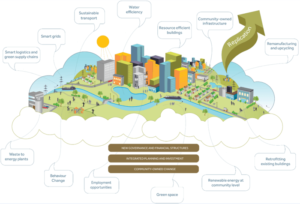Business growth strategies 2025 are essential for organizations aiming to thrive in an ever-evolving market landscape. As we look toward the future, it becomes crucial to understand the various approaches that can drive sustainable growth. This article will explore innovative strategies, the significance of data-driven decision-making, and emerging trends that will shape the business environment in the coming years.
From effective branding techniques to optimizing business processes, this comprehensive overview aims to equip you with the knowledge needed to navigate the complexities of business growth. By leveraging customer relationship management and strong leadership, companies can position themselves for success and capitalize on new opportunities.
Business Growth Strategies
In 2025, businesses must adopt a multi-faceted approach to growth to thrive in an increasingly competitive landscape. This evolution demands not just innovation but also an insightful understanding of market dynamics and consumer behavior. Effective growth strategies will hinge on leveraging technology, understanding customer needs, and making data-driven decisions to navigate challenges and seize opportunities.Growth strategies can encompass various methodologies, including market penetration, diversification, and product development.
These methods will enable companies to expand their market share, explore new product lines, and reach untapped customer segments. Emphasizing these strategies requires a clear understanding of the market landscape and the implementation of effective tools to assess performance continuously.
Importance of Data-Driven Decision-Making
Data-driven decision-making is essential for formulating successful growth strategies in today’s business environment. By utilizing analytics and data insights, businesses can make informed choices that align with current trends and customer preferences. The reliance on empirical evidence allows organizations to minimize risks and capitalize on opportunities.Data analytics can reveal consumer behaviors and preferences, enabling businesses to tailor their offerings accordingly.
For example, companies like Netflix analyze viewing habits to curate personalized recommendations, significantly enhancing customer satisfaction and retention. The utilization of customer relationship management (CRM) systems aids in tracking customer interactions, streamlining communication, and improving service quality.
Emerging Trends Influencing Business Growth
Several emerging trends are poised to shape business growth strategies in the upcoming years. Understanding these trends is critical for businesses aiming to remain competitive.
1. Sustainability and ESG Initiatives
Companies are increasingly prioritizing environmental, social, and governance (ESG) factors. Businesses that adopt sustainable practices are likely to attract a more conscientious customer base, as consumers are becoming more aware of their purchasing power.
2. Digital Transformation
The ongoing digitalization of businesses is an essential trend. Companies are integrating advanced technologies such as artificial intelligence (AI), machine learning, and automation into their operations to enhance efficiency and customer engagement.
3. Remote Work and Flexibility
The shift toward remote work has fundamentally changed workforce dynamics. Organizations that offer flexibility are finding it easier to attract and retain talent, which is vital for growth.
4. Customer-Centric Strategies
A focus on customer experience is becoming more prevalent. Businesses are leveraging feedback mechanisms and engagement platforms to create more personalized experiences, driving customer loyalty and repeat business.
5. Global Market Expansion
Companies are increasingly looking beyond local markets to expand globally. This requires an understanding of international regulations, cultural differences, and market demands. By adopting these trends into their growth strategies, companies can position themselves favorably to navigate the complexities of the market landscape in 2025.
“Data is the new oil; it’s valuable, but if unrefined, it cannot really be used.”
Branding Business

Effective branding is essential for business growth as we approach 2025. A strong brand not only fosters recognition but also builds trust and loyalty among customers. As the marketplace continues to evolve, businesses must adopt innovative branding techniques to stand out in an increasingly competitive environment.A compelling brand story captures the essence of a business and resonates deeply with target audiences.
This narrative should encapsulate your mission, values, and the unique experiences that define your brand. By forging an emotional connection with consumers, your brand can create a loyal customer base that advocates for your success.
Effective Branding Techniques
To enhance business growth through branding, consider implementing the following techniques that have been proven effective:
1. Unique Value Proposition (UVP)
Clearly define what sets your brand apart from competitors. Your UVP should focus on the specific benefits that customers can only receive from your business. For example, TOMS Shoes built its brand around the promise that for every pair purchased, another is donated to someone in need.
2. Visual Identity
Develop a cohesive visual identity that includes your logo, color palette, and typography. This visual consistency helps your brand become easily recognizable across various platforms. For instance, Coca-Cola’s red and white color scheme is instantly identifiable, contributing to brand recall.
3. Content Marketing
Utilize storytelling in your content marketing strategies. Share customer testimonials, case studies, or behind-the-scenes glimpses of your operations. This not only humanizes your brand but also highlights your commitment to quality and service.
4. Engagement on Social Media
Build a community by actively engaging with your audience on social media platforms. Respond to comments, participate in discussions, and share user-generated content. Brands like Nike excel at creating interactive campaigns that foster customer loyalty and brand advocacy.
5. Consistent Messaging
Ensure that your messaging is consistent across all channels, from your website to social media and email communications. This uniformity reinforces your brand identity and helps maintain customer trust. For instance, Apple’s messaging around innovation and simplicity is consistent across all its marketing materials.
Creating a Compelling Brand Story
A compelling brand story is vital in connecting emotionally with your audience. Here are ways to craft an engaging narrative that resonates:
Define Your Origins
Share how and why your business was founded. The story of Ben & Jerry’s highlights the founders’ commitment to social justice and environmental sustainability, making it relatable and inspiring for consumers.
Highlight Your Mission
Clearly articulate the mission and values of your brand. This should reflect a commitment to customers and social responsibility. For example, Patagonia’s dedication to environmental activism resonates with its audience and strengthens its brand identity.
Use Authentic Voice
The tone and voice of your brand story should reflect your brand personality. Use storytelling techniques that evoke emotions, whether through humor, inspiration, or empathy. Glossier successfully uses a relatable, conversational tone to make its beauty products feel more accessible and community-driven.
Customer Involvement
Involve your customers in your brand story. Encourage them to share their experiences with your products or services. Starbucks often features customer stories in its marketing, creating a sense of community and belonging.
Strategies for Maintaining Brand Consistency
Consistency is key to establishing a strong brand presence. Here are strategies to maintain brand consistency across various platforms:
Brand Guidelines
Develop comprehensive brand guidelines that Artikel your visual elements, tone, and messaging standards. This resource should be accessible to all employees and partners to ensure uniformity in all communications.
Regular Audits
Conduct regular audits of your branding across all platforms to identify inconsistencies. This proactive approach allows you to address any discrepancies before they affect customer perception.
Cross-Platform Integration
Ensure that all marketing materials, whether online or offline, reflect your brand’s identity. This includes email newsletters, social media, and print advertisements. For instance, Netflix maintains a consistent branding strategy by using similar visuals and messaging across all its marketing channels.
Training and Onboarding
Provide training for new employees on your brand values and guidelines. This ensures that everyone in the organization understands and embodies the brand promise, which is crucial for a cohesive customer experience.
Feedback Mechanisms
Implement feedback mechanisms to gather insights on how your brand is perceived across platforms. Customer feedback can inform adjustments to maintain brand consistency and adapt to evolving consumer expectations.
“A strong brand is the foundation of business growth; without it, success becomes a fleeting opportunity.”
Business Development and Management
In the ever-evolving landscape of business, effective management and strategic development are vital for fostering growth. Organizations need to adopt innovative methods that streamline operations, engage customers, and enhance overall productivity. The role of leadership is particularly crucial in steering these initiatives towards success and ensuring alignment with business objectives.
Optimizing Business Processes for Growth
Streamlining and optimizing business processes is essential for enhancing efficiency and driving growth. This involves evaluating existing workflows, identifying bottlenecks, and implementing improvements. Techniques such as process mapping, performance metrics, and automation can significantly contribute to achieving operational excellence.
- Process Mapping: Visualizing workflows helps identify inefficiencies and redundancies in operations. It allows managers to pinpoint areas for improvement and streamline processes effectively.
- Performance Metrics: Establishing key performance indicators (KPIs) enables businesses to track progress and measure success. Regular analysis of these metrics aids in making informed decisions and adjustments.
- Automation: Utilizing technology to automate repetitive tasks reduces manual effort and minimizes errors. This leads to increased productivity and allows employees to focus on more strategic initiatives.
Leadership in Business Development Initiatives
Leadership plays a pivotal role in influencing business development strategies and initiatives. Effective leaders inspire and motivate their teams, fostering a culture of innovation and collaboration. They set the vision and direction, ensuring alignment with the overall goals of the organization.
- Vision Setting: Strong leaders articulate a clear and compelling vision that guides the organization toward its objectives. This vision serves as a roadmap for decision-making and strategic planning.
- Team Empowerment: Empowering employees by delegating authority and encouraging initiative fosters a sense of ownership. This leads to increased engagement and drives innovative solutions.
- Change Management: Leaders must effectively manage change by communicating transparently and addressing concerns. Successful change management helps organizations navigate transitions smoothly and maintain momentum.
Importance of Customer Relationship Management
Customer relationship management (CRM) is a cornerstone of achieving business objectives. A robust CRM strategy enhances customer satisfaction, loyalty, and retention, which are critical for sustained growth.
- Understanding Customer Needs: CRM systems enable businesses to gather and analyze customer data, providing insights into preferences and behaviors. This information helps tailor products and services to meet customer expectations.
- Effective Communication: Maintaining open lines of communication through CRM tools allows businesses to engage with customers proactively. Personalized interactions build stronger relationships and trust.
- Feedback Integration: Actively seeking and integrating customer feedback into business strategies demonstrates a commitment to improvement. It helps organizations adapt to changing market demands and enhances customer loyalty.
“Successful businesses understand that optimizing processes, cultivating leadership, and managing customer relationships are essential components of sustainable growth.”
Last Word

In conclusion, embracing the right business growth strategies for 2025 will be pivotal for organizations seeking to remain competitive. The importance of data-informed decisions, compelling branding, and efficient management cannot be overstated. By integrating these elements, businesses can not only meet their growth objectives but also foster lasting relationships with their customers, ensuring a prosperous future.
Top FAQs
What are the key components of a growth strategy?
A successful growth strategy typically includes market analysis, competitive positioning, branding, and customer engagement processes.
Why is data-driven decision-making important?
Data-driven decision-making allows businesses to make informed choices that enhance efficiency and align with market demands, ultimately improving outcomes.
How can branding impact business growth?
Effective branding helps establish a strong identity, fosters customer loyalty, and differentiates a company from its competitors, driving growth.
What role does leadership play in business growth?
Leadership guides strategic initiatives, inspires team members, and fosters a culture of innovation and accountability, all of which are vital for growth.
What trends should businesses watch for in 2025?
Emerging trends may include advancements in technology, shifts in consumer behavior, sustainability practices, and increased competition in digital marketplaces.





